B is for biographies! Readers will learn about the lives and works of both well-known historical figures, such as Marie Curie and Jackie Robinson, and lesser known people, such as John Deere and Sophie Blanchard, in the recently published books reviewed this week. Fascinating stories of accomplishments, at times of hardships and discrimination, abound in this bunch of biographies.
Ages 4–8
Alexander Graham Bell Answers the Call. Mary Ann Fraser. 2017. Charlesbridge.
 Fraser’s picture book biography of Alexander (“Aleck”) Graham Bell (1847–1922) begins with his childhood in Scotland and how he became interested in the science of sound. Bell’s mother was partially deaf, and his father was a speech therapist. Throughout his life, Bell experimented with sound, eventually partnering with Thomas Watson on his famous invention, the telephone. Lively cartoon-style multimedia illustrations complement the accessible text. Text boxes inserted throughout the book give readers short bursts of related information. Back matter includes information about Bell’s many inventions, a timeline, and a note from the author on her inspiration for writing a biography of Bell and using a photographic collage technique in the illustrations. Fascinating photographs on the endpapers provide a visual timeline of the evolution of the telephone from 1876–1989.
Fraser’s picture book biography of Alexander (“Aleck”) Graham Bell (1847–1922) begins with his childhood in Scotland and how he became interested in the science of sound. Bell’s mother was partially deaf, and his father was a speech therapist. Throughout his life, Bell experimented with sound, eventually partnering with Thomas Watson on his famous invention, the telephone. Lively cartoon-style multimedia illustrations complement the accessible text. Text boxes inserted throughout the book give readers short bursts of related information. Back matter includes information about Bell’s many inventions, a timeline, and a note from the author on her inspiration for writing a biography of Bell and using a photographic collage technique in the illustrations. Fascinating photographs on the endpapers provide a visual timeline of the evolution of the telephone from 1876–1989.
John Deere, That’s Who! Tracey Nelson Maurer. Ill. Tim Zeltner. 2017. Henry Holt.
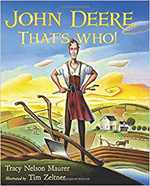 Did you know that John Deere did not invent the big green tractors that many people associate with his name? It’s true. This biography introduces young readers to John Deere (1804–1886), the young blacksmith who invented a new type of steel plow that could handle the thick, sticky soil of Illinois fields. Illustrations, rendered with acrylic paint on plywood, evoke an old-fashioned feel to this biographical account of the inventor and manufacturer. Back matter includes a glossary, a list of facts about John Deere and the manufacturing company that bears his name, a detailed bibliography, and acknowledgments from the author.
Did you know that John Deere did not invent the big green tractors that many people associate with his name? It’s true. This biography introduces young readers to John Deere (1804–1886), the young blacksmith who invented a new type of steel plow that could handle the thick, sticky soil of Illinois fields. Illustrations, rendered with acrylic paint on plywood, evoke an old-fashioned feel to this biographical account of the inventor and manufacturer. Back matter includes a glossary, a list of facts about John Deere and the manufacturing company that bears his name, a detailed bibliography, and acknowledgments from the author.
Lighter Than Air: Sophie Blanchard, the First Woman Pilot. Matthew Clark Smith. Ill. Matt Tavares. 2017. Candlewick.
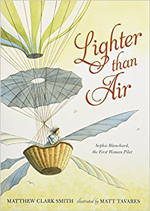 In this picture book biography, readers learn about the life and dreams of Sophie Blanchard (1778–1819), a French woman who was married to famous balloonist Jean-Pierre Blanchard. She yearned to go up into the air by herself and did so, becoming the first female to pilot a hot-air balloon in 1805. Later she was named chief air minister of ballooning by Emperor Napoleon. Ink-and-watercolor illustrations depict each scene in fine-line, colorful detail. Back matter includes brief notes from the author and the illustrator and a list of selected sources.
In this picture book biography, readers learn about the life and dreams of Sophie Blanchard (1778–1819), a French woman who was married to famous balloonist Jean-Pierre Blanchard. She yearned to go up into the air by herself and did so, becoming the first female to pilot a hot-air balloon in 1805. Later she was named chief air minister of ballooning by Emperor Napoleon. Ink-and-watercolor illustrations depict each scene in fine-line, colorful detail. Back matter includes brief notes from the author and the illustrator and a list of selected sources.
Long-Armed Ludy and the First Women’s Olympics. Jean L. S. Patrick. Ill. Adam Gustavson. 2017. Charlesbridge.
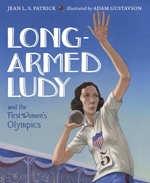 Lucille “Ludy” Godbold (1900–1981) was born in South Carolina, at a time when women were not permitted to do many of the things that men could do, including participate in the Olympics. However, Ludy was selected as one of fifteen American women to participate in the 1922 Women’s World Games, the “First Women’s Olympics,” a world-class event organized by Alice Milliat of France. Ludy went on to become a world-champion athlete who excelled in many events including the shot put, which is the featured event in this picture book biography. Bright and whimsical oil paintings capture the time period and depict Ludy as the tall and lanky athlete she was. Back matter includes an author’s note and two photographs of Ludy Godbold.
Lucille “Ludy” Godbold (1900–1981) was born in South Carolina, at a time when women were not permitted to do many of the things that men could do, including participate in the Olympics. However, Ludy was selected as one of fifteen American women to participate in the 1922 Women’s World Games, the “First Women’s Olympics,” a world-class event organized by Alice Milliat of France. Ludy went on to become a world-champion athlete who excelled in many events including the shot put, which is the featured event in this picture book biography. Bright and whimsical oil paintings capture the time period and depict Ludy as the tall and lanky athlete she was. Back matter includes an author’s note and two photographs of Ludy Godbold.
Marie Curie (Little People, Big Dreams). Isabel Sánchez Vegara. Trans. Emma Martinez. Ill. Frau Isa. 2017. Frances Lincoln.
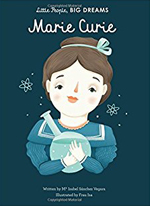 This picture book biography gives young readers a sense of the accomplishments of Marie Curie (1867–1934), the scientist who discovered radium and polonium and is the only female to win two Nobel Prizes, one for physics and one for chemistry. Spare text and colorful stylized illustrations offer a child-friendly inspiring account of how Curie, who as a young child declared her determination “to be a scientist, not a princess,” overcame much discrimination, as many people believed that women should not be educated—especially in the field of science—in the late 1800s and early 1900s. Back matter includes a timeline of Marie’s life, photographs, and an author’s note with more details of Curie’s life and work.
This picture book biography gives young readers a sense of the accomplishments of Marie Curie (1867–1934), the scientist who discovered radium and polonium and is the only female to win two Nobel Prizes, one for physics and one for chemistry. Spare text and colorful stylized illustrations offer a child-friendly inspiring account of how Curie, who as a young child declared her determination “to be a scientist, not a princess,” overcame much discrimination, as many people believed that women should not be educated—especially in the field of science—in the late 1800s and early 1900s. Back matter includes a timeline of Marie’s life, photographs, and an author’s note with more details of Curie’s life and work.
Ages 9–11
Newton’s Rainbow: The Revolutionary Discoveries of a Young Scientist. Kathryn Lasky. Ill. Kevin Hawkes. 2017. Farrar, Straus and Giroux.
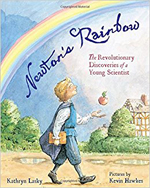 This illustrated biography of Isaac Newton (1642–-1727) gives a detailed account of his early life as a curious but not-so-good student and, later, as a college scholar. Lasky addresses the legendary apple-falling story related to Newton’s explanation of the forces of motion and gravity as well as his other contributions to science, including the “secret” of the rainbow— the discovery that white light is actually made of colors. Ink-and-watercolor paintings add interesting details for younger readers. A bibliography is included.
This illustrated biography of Isaac Newton (1642–-1727) gives a detailed account of his early life as a curious but not-so-good student and, later, as a college scholar. Lasky addresses the legendary apple-falling story related to Newton’s explanation of the forces of motion and gravity as well as his other contributions to science, including the “secret” of the rainbow— the discovery that white light is actually made of colors. Ink-and-watercolor paintings add interesting details for younger readers. A bibliography is included.
Ruth Bader Ginsburg: The Case of R.B.G. vs. Inequality. Jonah Winter. Ill. Stacy Innerst. 2017. Abrams.
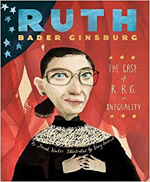 This picture book biography of Supreme Court Justice Ruth Bader Ginsburg (R.B.G.), who was born in Brooklyn in 1933, begins with her childhood as a determined young girl who refused to be daunted by discrimination for either her religion or gender. The text opens with readers being asked to serve as the jury in “the Case of R.B.G. vs. Inequality.” Presentation of the facts of the case include “exhibits” of how R.B.G. pursued her dream of going to law school and overcame obstacles to have a successful legal career, eventually becoming the second woman ever appointed to the Supreme Court. The muted tones of the illustrations, rendered in gouache, ink, and Photoshop, complement the text. Back matter includes a glossary and an author’s note.
This picture book biography of Supreme Court Justice Ruth Bader Ginsburg (R.B.G.), who was born in Brooklyn in 1933, begins with her childhood as a determined young girl who refused to be daunted by discrimination for either her religion or gender. The text opens with readers being asked to serve as the jury in “the Case of R.B.G. vs. Inequality.” Presentation of the facts of the case include “exhibits” of how R.B.G. pursued her dream of going to law school and overcame obstacles to have a successful legal career, eventually becoming the second woman ever appointed to the Supreme Court. The muted tones of the illustrations, rendered in gouache, ink, and Photoshop, complement the text. Back matter includes a glossary and an author’s note.
Ages 12–14
42 Is Not Just a Number: The Odyssey of Jackie Robinson, American Hero. Doreen Rappaport. 2017. Candlewick.
 Jackie Robinson (1919–1972), one of the best baseball players in history, is most remembered as the man who broke the color barrier in major league baseball when he took the field as first baseman for the Brooklyn Dodgers on April 15, 1947. This biography covers Robinson’s early years, beginning when Jackie was eight years old and one of five siblings being raised by his mother in California. Jackie’s baseball career began in the Negro Leagues in 1945. He was recruited the next year by Brooklyn Dodgers Manager Branch Rickey, who envisioned Jackie and another player becoming the first African Americans to play on a major league team. The road to this eventual victory was not easy, as Jackie faced seemingly insurmountable challenges along the way. Today he is viewed as an American hero for his brave stance against discrimination. Back matter includes an author’s note, a timeline, extensive source notes providing details to support the quotes and statements in each chapter, a selected bibliography, additional resources, and an index.
Jackie Robinson (1919–1972), one of the best baseball players in history, is most remembered as the man who broke the color barrier in major league baseball when he took the field as first baseman for the Brooklyn Dodgers on April 15, 1947. This biography covers Robinson’s early years, beginning when Jackie was eight years old and one of five siblings being raised by his mother in California. Jackie’s baseball career began in the Negro Leagues in 1945. He was recruited the next year by Brooklyn Dodgers Manager Branch Rickey, who envisioned Jackie and another player becoming the first African Americans to play on a major league team. The road to this eventual victory was not easy, as Jackie faced seemingly insurmountable challenges along the way. Today he is viewed as an American hero for his brave stance against discrimination. Back matter includes an author’s note, a timeline, extensive source notes providing details to support the quotes and statements in each chapter, a selected bibliography, additional resources, and an index.
Jack London and the Klondike Gold Rush. Peter Lourie. Ill. Wendell Minor. 2017. Henry Holt.
 Most people know Jack London (1876–1916) as the author of Call of the Wild, one of the most well-known animal adventure stories of all time. But people might not know that London got the inspiration for that story—and many others that he wrote—from his time as an adventure-seeker during the Alaskan Gold Rush of 1897. London helped his financially struggling family by joining thousands of others hoping to “strike it rich” in the Klondike. Jack and the men in his group had to carry their own gear and traverse over 600 miles, most of it by walking. The journey was long and arduous, and many men died along the way. London spent two years in Alaska mining for gold, but was largely unsuccessful and had to leave the wilderness to be treated for scurvy. Instead of gold nuggets, London found the nuggets for stories, and would eventually go on to publish several books, many short stories, and articles based on his days in the Klondike. Back matter includes an afterword, notes from the author, notable places, London’s writings, an illustrated timeline, a glossary, a bibliography and sources, and an index. Minor’s expressive black-and-white illustrations and captioned archival photographs provide additional historical context.
Most people know Jack London (1876–1916) as the author of Call of the Wild, one of the most well-known animal adventure stories of all time. But people might not know that London got the inspiration for that story—and many others that he wrote—from his time as an adventure-seeker during the Alaskan Gold Rush of 1897. London helped his financially struggling family by joining thousands of others hoping to “strike it rich” in the Klondike. Jack and the men in his group had to carry their own gear and traverse over 600 miles, most of it by walking. The journey was long and arduous, and many men died along the way. London spent two years in Alaska mining for gold, but was largely unsuccessful and had to leave the wilderness to be treated for scurvy. Instead of gold nuggets, London found the nuggets for stories, and would eventually go on to publish several books, many short stories, and articles based on his days in the Klondike. Back matter includes an afterword, notes from the author, notable places, London’s writings, an illustrated timeline, a glossary, a bibliography and sources, and an index. Minor’s expressive black-and-white illustrations and captioned archival photographs provide additional historical context.
Ages 15+
Eyes of the World: Robert Capa, Gerda Taro, and the Invention of Modern Photojournalism. Marc Aronson & Marina Budhos. 2017. Henry Holt.
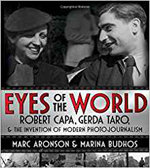 In this well-researched and meticulously documented biography, readers learn about husband-and-wife photography team Robert Capa (1913–1954) and Gerda Taro (1910–1937). Capa and Taro are recognized as pioneers in photojournalism for their outstanding photographing of modern warfare during the Spanish Civil War in the 1930s. Later, Capa would capture some of the most iconic scenes from the World War II D-Day invasion in 1944. This biography is told with photos, primary source documents, and text that fully immerses the reader in the time period in which Capa and Taro lived. Back matter includes a “cast of characters” providing further information on key people, a timeline, chapter-by-chapter notes, a list of web resources, and an index. Additionally, Aronson and Budhos discuss their collaboration on this project which was an important endeavor for them.
In this well-researched and meticulously documented biography, readers learn about husband-and-wife photography team Robert Capa (1913–1954) and Gerda Taro (1910–1937). Capa and Taro are recognized as pioneers in photojournalism for their outstanding photographing of modern warfare during the Spanish Civil War in the 1930s. Later, Capa would capture some of the most iconic scenes from the World War II D-Day invasion in 1944. This biography is told with photos, primary source documents, and text that fully immerses the reader in the time period in which Capa and Taro lived. Back matter includes a “cast of characters” providing further information on key people, a timeline, chapter-by-chapter notes, a list of web resources, and an index. Additionally, Aronson and Budhos discuss their collaboration on this project which was an important endeavor for them.
Jennifer W. Shettel is an associate professor at Millersville University of PA where she teaches undergraduate and graduate course in literacy for preservice and practicing teachers. Prior to joining the faculty at Millersville, she spent 16 years as an elementary classroom teacher and reading specialist in the public schools.
These reviews are submitted by members of the International Literacy Association's Children's Literature and Reading Special Interest Group (CL/R SIG) and are published weekly on Literacy Daily.